Content
- 1 How to care for decorative heather in the garden
- 2 Common heather varieties for open ground in the Moscow region (with photo)
- 3 Where does blooming heather grow (with photo)
- 4 Heather varieties and photos of its flowers
- 5 Growing conditions, planting and caring for heather outdoors
- 6 An unforgettable gift of autumn
- 7 Soil preparation
- 8 Planting heather
- 9 Heather: care
- 10 Heather varieties
 Growing heather in the garden is one of the easiest things a budding grower can do. A wide variety of varieties of common heather with flowers of various colors makes it possible to use this undersized shrub to compose compositions in different colors. Minimal maintenance is required for decorative heather, the main thing is to avoid trimming old wood in late autumn.
Growing heather in the garden is one of the easiest things a budding grower can do. A wide variety of varieties of common heather with flowers of various colors makes it possible to use this undersized shrub to compose compositions in different colors. Minimal maintenance is required for decorative heather, the main thing is to avoid trimming old wood in late autumn.
How to care for decorative heather in the garden
Landing features. The distance between plants is 0.3-0.4 m in groups or per 1 m2, 6-8 specimens of strong-growing and 12-15 weak-growing varieties are planted. Planting depth 25-35 cm strictly to the level of the root collar. It is better to plant in open sunny places at the age of 1.5-2 years, when the plants have the greatest decorative effect. For planting and successfully growing heather, it is better to use a soil mixture of the following composition: peat, sand, bark compost or coniferous soil (3: 1: 2). Coniferous land is a semi-decomposed litter of a coniferous forest, spruce or better pine, it is taken from a depth of 5-7 cm.The substrate must be acidic (pH = 4.5-5.5), therefore, red high-moor peat is used (pH = 3.2 ). Planting time: second half of April - early May or autumn in late September - early October. Dry weather is not an obstacle for planting, if the plant is pre-watered abundantly. Drainage is needed if the soil is clayey, and consists of sand and broken brick with a layer of 5-10 cm.
Top dressing. When growing and caring for heather, it is recommended to annually feed the complete mineral fertilizer "Kemira Universal": 1 tablespoon per 10 liters of water. When planting, 1 matchbox of nitrophoska and 2 tablespoons of horn flour for low-growing varieties of heather and 2 matchboxes of nitrophoska and horn flour for vigorous varieties are added to the substrate.
Mulching. A necessary condition for growing heather is mandatory mulching immediately after planting with peat or coniferous wood chips, since it contains the necessary mycorrhiza.
Pruning. Pruning is done in moderate spring. Intensive pruning is not recommended for the first two years after planting. After flowering in autumn or early spring, old plants are cut with pruning shears so as to capture part of the stem below the faded inflorescences. In the process of caring for decorative heather, it is necessary to maintain the shape of the crown when pruning. Avoid pruning old wood in late fall when some heathers are cut for winter bouquets.
Preparing for winter. When growing and caring for heather in the garden in late autumn, when the soil is 5-7 cm frozen (about November 10), it is recommended to sprinkle peat or a dry leaf with a layer of up to 10 cm on top of the plant. In mid-April, the shelter must be removed, the peat must be removed from the root collar in order to ensure the full flowering of the heather.
The photo "Growing and caring for heather" shows all the main agricultural techniques:
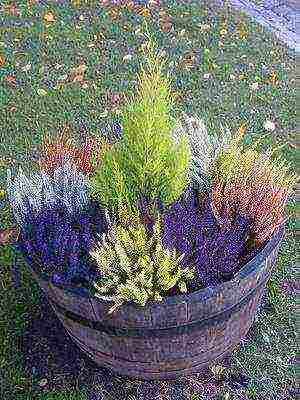
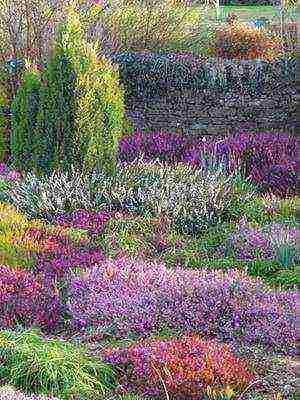
Common heather varieties for open ground in the Moscow region (with photo)
Heather (Calluno) is a plant from the Heather family. Common heather (C. vulgaris) is a low-growing shrub, 20-70 cm tall. The crown is quite compact, almost round.
As you can see in the photo, the heather shrub has flowers on short pedicels, several pieces are collected in dense racemose inflorescences up to 25 cm long, lilac-pink, rarely white:
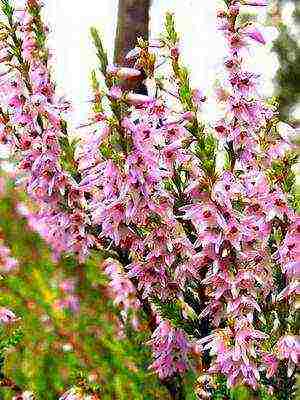
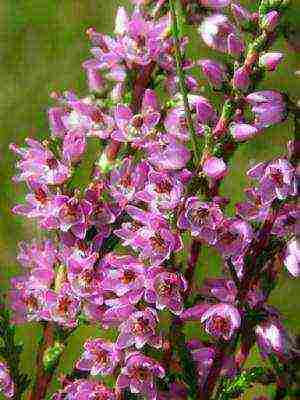
Flowering time: July August. Photophilous, withstands weak partial shade. It hibernates without shelter, it is quite winter-hardy. For cultivation in the gardens of central Russia, the best varieties are:
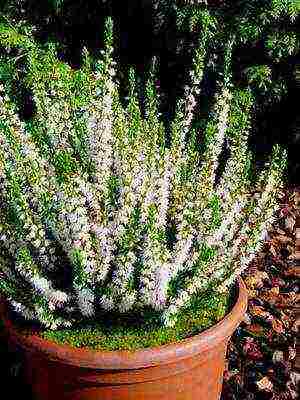
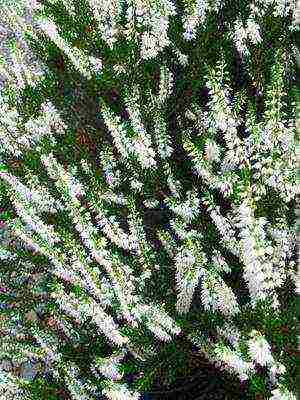
"Alba Plena" ("Alba Plena") - a low evergreen shrub 20-40 cm high, with a crown diameter of 40-45 cm. The crown is compact, spherical. The flowers are white, double. Decorativeness manifests itself during abundant and prolonged flowering, in August-September, 50 days. Winter-hardy. It is better to cover young plants with a dry leaf and spruce branches for the winter.
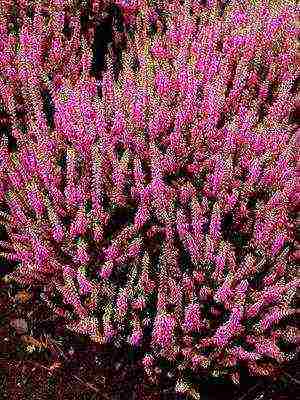
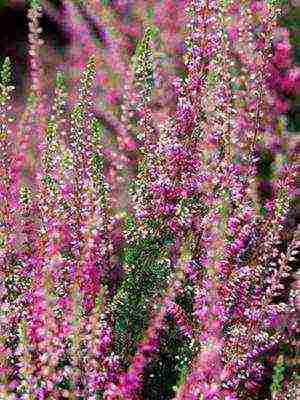
"Allegro" ("Allegro") - height 40-50 cm, rarely 60 cm, crown diameter 50 cm. The crown is compact, dense. Blooms in the suburbs from early August to late September. The flowers are simple, shiny, carmine red. Winter-hardy.

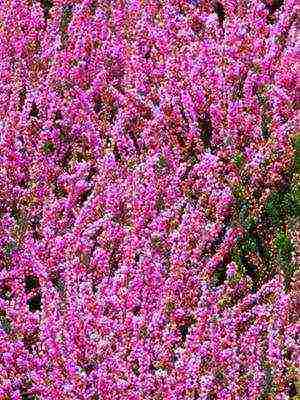
"Annemarie" ("Annemarie") - height 40-50 cm, crown diameter 60 cm. The crown is loose, wide-bushy. Blooms from late July to late October. The buds are purple-red, later the flowers turn dark pink. Terry flowers.
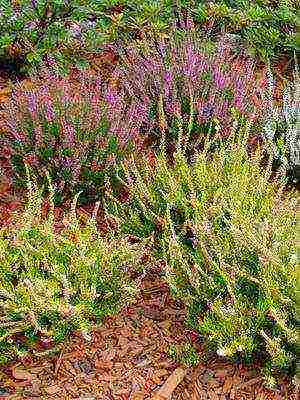
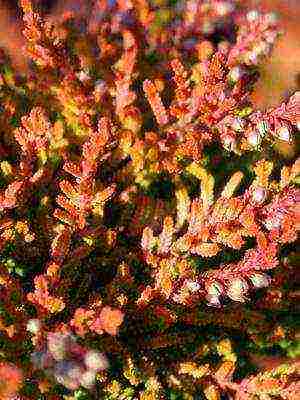
"Boskop" ("Boskoop") - height 30-40 cm, crown diameter 40-50 cm. The crown is compact. Leaves are coppery orange-red in autumn and winter. Outdoors, this heather variety blooms from August 25 to late September. The flowers are lilac-pink, simple.

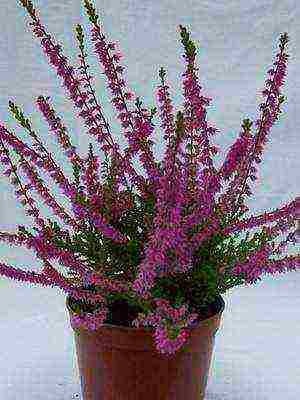
"Carmen" ("Carmen") - height 30-40 cm, crown diameter 40-50 cm. The crown is broadly oval or spherical. Blooms in Moscow from early September to mid-October, 45 days. The flowers are simple, pink-purple.


"Darkness" ("Darkness") - height 30-35 cm, diameter of a compact, dense, spherical crown 40-50 cm. It blooms from late August to mid-October, abundantly, about 50 days.
Look at the photo - the decorative heather of this variety has simple, purple-red flowers, densely located on peduncles up to 15 cm long:

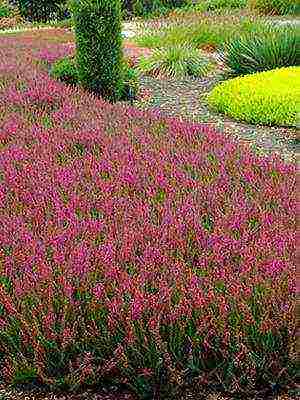
"Dark Star" ("Dark Star") - height 20-30 cm, crown diameter up to 40 cm. The crown is compact, spherical. Blooms profusely from late August to late September, 30 days, rarely until early October. The flowers are semi-double, ruby red, shiny. Weak bush, annual growth of 3-5 cm.
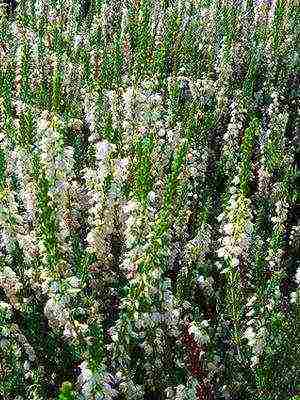
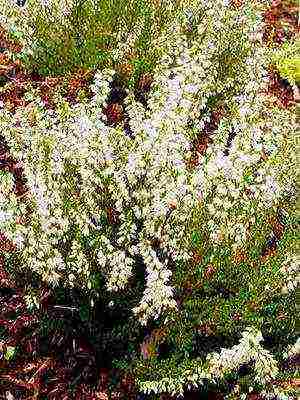
Long White ("Long White") - height 40-60 cm, crown diameter 60-70 cm. The crown is loose, spherical. In Moscow, it blooms profusely from late August to early October, 40 days, in Europe - from September to late October. The flowers are white, simple, collected in long inflorescences (25-30 cm).
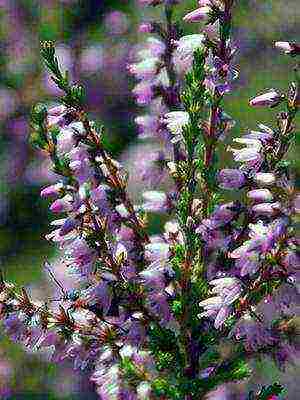
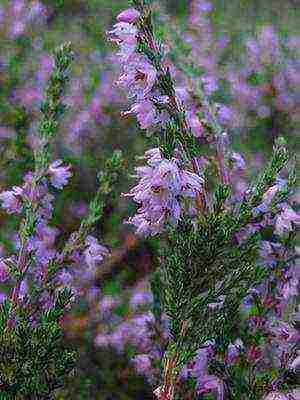
"Marlin" ("Marleen") - height 20-30 cm, crown diameter 40-50 cm. The crown is compact. In Moscow, it blooms profusely from late August to late October, 65 days, in Europe, September-November. The buds are pink-lilac or bright purple, never open.
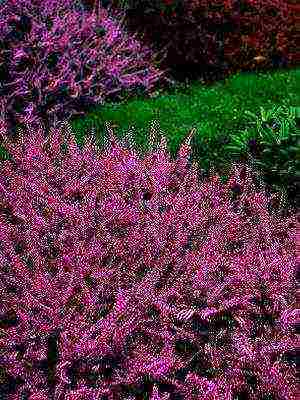
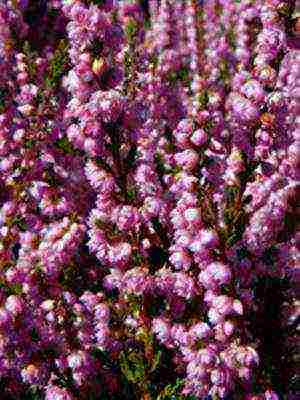
Peter Sparks ("Peter Sparkes") - height 40-50 cm, crown diameter 50-60 cm. The crown is oval. This variety of heather in the Moscow region blooms from early September to late October, 55 days, abundantly, in Europe - in September-November. The flowers are double, dark pink.


"Radnor" ("Radnor") - height 20-30 cm, crown diameter 40-50 cm. The crown is compact. Blooms in the suburbs from August 20 to mid-October, about 50 days. Terry flowers, pale pink, collected in inflorescences 10 cm long.
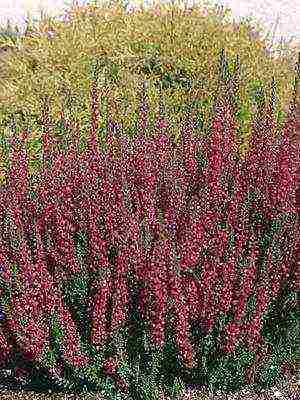
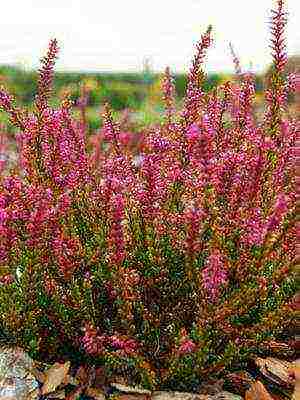
"Red Star" ("Red Star") - height 20 cm, crown diameter 40-50 cm. The crown is compact, spherical. Blooms in the suburbs from mid-September to early November. Double flowers, red. Densely located on long (more than 10 cm) inflorescences. Profuse and late long flowering, 48 days. A very beautiful variety.

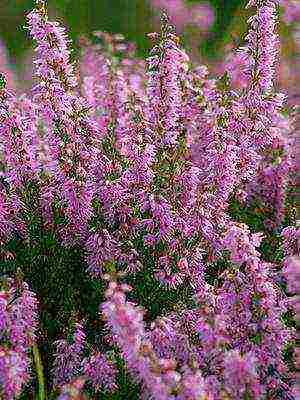
Silver Knight ("Silver Knight") - height 20-30 cm, crown diameter 40-45 cm. The crown is compact, pillow-shaped. In winter, the leaves take on a purple hue. Very beautiful foliage. Blooms profusely in the Moscow region from mid-August, about 45 days. The flowers are simple, light purple or lilac.
As shown in the photo, at the heather of this variety, the tops of the non-flowering shoots are drooping:
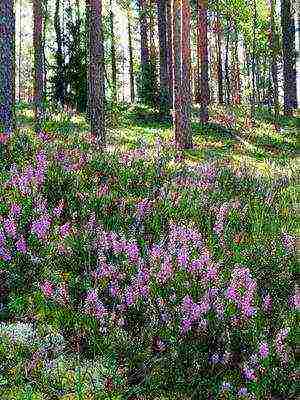
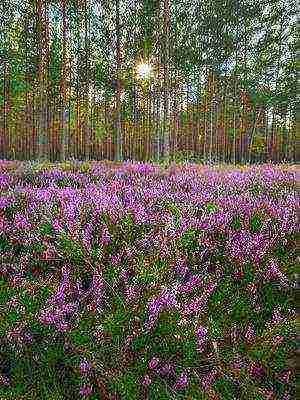
The garden centers are currently receiving varieties from the Garden Girls and Beauty Ladies series. These plants are interesting because their buds never open.
Where does blooming heather grow (with photo)
Heather (Calluna, Russian transcription - calluna) belongs to the Heather family, its homeland is Asia, North Africa, Greenland, America.
The Latin name for heather comes from the ancient Greek verb "kalynein" - "to clean", which is explained by the functional purpose of the plant, the bundles of which were used to clean the room like a broom. Heather comes from the heather family and is the closest relative of the rhododendron, despite the complete lack of external similarity between the two species.
Look at the photo - the leaves and flowers of the heather plant are so small and numerous that from a distance the heather thickets resemble light curly clouds:
Heather is common in the western Mediterranean, in the mountains of eastern Africa, Arabia and Asia Minor, Madeira and the Canary Islands. A related species E. azorica - Azores heather grows in the Azores. Where heather grows in its natural habitat, over the years the bush grows up to several meters in height. Its orange-brown trunks are intertwined. Fire resistant root wood is used to make smoking pipes. In a pot or tub, Erica grows very slowly, but blooms extremely profusely in early spring, when the stems are literally strewn with countless tiny white flowers.
Common heather plant (C. vulgaris) is an evergreen undersized shrub 30 - 70 cm tall, with rigid, erect stems. Differs in extreme undemanding to soil conditions. Has a beautiful compact crown. The leaves are small, tiled-needle-like, without petioles, similar to the needles of spruce, up to 2 mm long.
As you can see in the photo, blooming heather is a lilac-pink or carmine-red thickets:
The flowers of the plant are shiny, small, similar to bells, collected in one-sided racemose inflorescences. It blooms late - in late summer, and more often in early autumn. Heather fruits are capsules containing many small seeds.
In central Russia, the shrub requires protection from frost: the plant should be covered with spruce branches or dry leaves. You need to plant heather in bright sunny areas. Requires acidic soils (pH 4.5-5.5).
Pay attention to the photo - heather flowers are most often planted together with the plants with which it grows side by side in the wild: juniper, cotoneaster, broom, erika:
Often, group plantings of heathers are arranged under tall trees with a sparse crown, which sufficiently transmits the sun's rays. On the border of the heather thickets and the rest of the rocky garden, unpretentious and undemanding perennial plants are planted, smoothing the abrupt transition and creating the illusion of an integral garden space.
Common heather (Calluna vulgaris) naturally blooms with pinkish-purple flowers. However, in decorative floriculture, wild heather is usually not used, giving preference to its cultivated varieties and varieties with a wide variety of flower colors.
Heather varieties and photos of its flowers
Here you can find photos and descriptions of the most popular heather varieties.
1. Allegro - an evergreen plant 40-50 cm high with a small dense crown 50 cm in diameter. Leaves are dark green in color. It blooms profusely every year from the beginning of August until the end of September with shiny red flowers, collected in long, up to 30 cm in size, unbranched inflorescences.
2. Annemarie is an upright shrub 40-50 cm high, with a crown 60 cm in diameter. In autumn, the leaves of the bush are dark green in color, in winter and spring they turn gray-green. They are small, up to 2 mm long and 0.6 mm wide, resemble scales. This variety of heather blooms from late July to late October, especially plentifully in September with double flowers, which gradually change from one color to another. The purple-red buds become dark pink as they unfold. Long, up to 20 cm, inflorescences look decorative.
3. Boskop - a plant that forms a bush with a height of 30–40 cm.Has a compact crown with a diameter of 40-50 cm with branches pointing up. This heather variety has very beautiful leaves, yellow-green in summer and orange-red in autumn. Young plants of this variety of common heather have a brighter color of leaves than old ones. It blooms profusely from late August to early November with light lilac flowers, collected in inflorescences about 10 cm long.
4. Long White - one of the tallest varieties of this species, reaching a length of 60–70 cm. Its shoots grow upward.
As shown in the photo, common heather of this variety has a loose spherical crown with a diameter of 50 cm and small leaves of bright green color:
Blooms profusely from late August to early November with white long clusters.
5. Silver Knight is a dense shrub 20-30 cm high, with a compact crown 40 cm in diameter, cushion-shaped. In summer, the leaves of the plant are silvery, purple in late autumn. Blooms from August to early October.
Look at the photo - this variety of heather blooms with light purple flowers that adorn the bright red stamens:
Sometimes flowering continues until the first snow falls.
In garden design, heather is planted in the foreground of the site, along the paths, and parterre places are made out for them. And tall bushes, such as rhododendron, or conifers can serve as a background. Heather can also be planted on alpine slides and decorated with curbs.
Tall (50 cm) "Alba Erecta" and miniature (10 cm) "Pumile" with white non-double flowers,
spreading "Alba Plena" with erect stems and white double flowers,
tall (50 cm) Alportii with erect stems and bright purple-red flowers,
undersized "Camla" with pink double flowers,
undersized "Country Wicklow" with double light pink flowers,
unusually spectacular "Cuprea" with bright yellow-green foliage, which turns red-brown in winter, and light purple non-double flowers,
large "N. E. Beale " with erect stems and pink double flowers with a white center, collected in long cluster-shaped inflorescences,
J. N. Hamilton " with yellow-pink double flowers,
compact "Mullion" with densely branching stems and dark pink flowers.
Most varieties bloom in August-September. Alba Plena and Pumile bloom until frost. Many varieties do not lose their attractiveness even in winter.
Growing conditions, planting and caring for heather outdoors
When planting, for ease of caring for heather in the open field, a distance of 30–40 cm is left between the bushes. The planting depth is 25–35 cm. The plant takes root better in open sunny areas at the age of two years. The substrate is prepared from peat, sand, bark compost in a ratio of 3: 1: 2. The soil must be acidic. Therefore, for its preparation, peat with an acid-base balance equal to 3, 2 is used. Planting is carried out in late April - early May or in autumn, late September - early October.
One of the main conditions for growing heather is the presence of humus-rich sandy soils with an acid reaction, high peat content. At the same time, heather does not tolerate excess lime. Heather thickets grow rapidly, filling the rocky slopes, so it is not customary to arrange them in a small garden area. This plant needs space! And if it is enough, then you will not regret that you planted heather on your site. At the same time, it is recommended to plant large areas with one variety of heather or several varieties that form flowers of the same color. Thanks to the dense and extremely picturesque heather thickets, your site will turn into a fabulous corner until autumn.
When planting and caring for ordinary heather, do not forget that this plant is extremely photophilous. It reacts to a lack of lighting with poor flowering and slow growth.In this case, the shoots are stretched and thinned. Heather thickets practically do not require special care, even with weeds you will not have to fight, since the heather will displace them on its own, without human help. In this case, you will only have to make sure that the heather does not crowd out its cultural neighbors. Therefore, the stems of faded plants are shortened, and old individuals are cut from time to time in the spring. Occasionally, heather thickets are sprinkled with peat. During the growing season, heather needs abundant watering. The rest of the time, the plant tolerates the lack of moisture well enough. In a dry, snowless winter, when growing heather, the plant needs shelter, in other cases, although it freezes under sub-zero temperatures, it quickly recovers with the onset of warm weather.
Heather reproduces by layering and dividing the bush (in spring), as well as by semi-lignified cuttings, cut before budding, in a cold greenhouse (in summer).
Growing and caring for heather is carried out in slightly acidic, humus-rich soil, which must be evenly moistened in summer. Heather loves warmth and sun, as well as fresh air. Therefore, it is recommended to keep it outdoors and not in a greenhouse. In winter, however, it must be brought into the room. But even here, in a cold and very bright place, he needs ventilation. Keep the temperature below 15 ° C, otherwise the heather will start to grow and, accordingly, will not bloom in the spring. During this time, water sparingly, but do not allow the soil to completely dry out.
Common heather bushes are planted in a conspicuous place in the garden, they make good curbs. Some varieties of heather can also be used as ground cover plants on alpine hills, near large stones, near small bodies of water. Blossoming branches serve as delightful bouquets. Heather should be planted in sunny areas, sheltered from the wind. The best varieties of heather for the Moscow region are: ‘Allegro’ - carmine-red flowers, ‘Long White’ - pure white flowers, as well as ‘Marlene’, ‘Annemaria’, etc.
When caring for heather, plants generally need a little pruning. The first 2 - 3 years after planting heather in a permanent place, pruning is not carried out at all. Only broken and diseased branches are removed, as well as branches that interfere with obtaining a compact bush. At an older age, they carefully break off the faded flowers with their hands in order to prevent the setting of seeds.
As shown in the photo, when caring for heather, the tops of the shoots are removed annually with scissors:
In old plants, after the end of flowering, part of the stems located below the faded inflorescences are cut out with garden scissors, while capturing damaged and diseased shoots.
Try to keep the shape of the bush when pruning. Bushes with such pruning become more compact and dense. Pruning and shaping is best done in the spring.
Check out the photo of heather care for a better understanding of how to care for this plant:
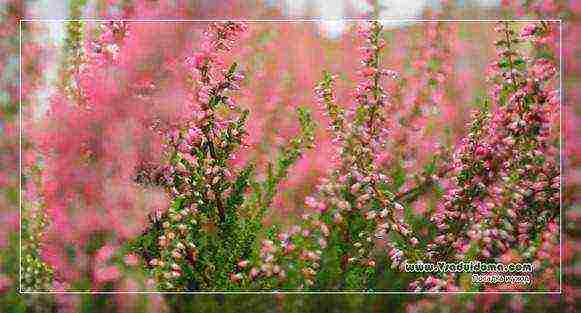
An unforgettable gift of autumn
When there are almost no flowering plants and green perennials left in the flower beds, your garden can shine with colorful colors of flowering heathers. This small shrub, all covered with tiny bright flowers, will be the most unforgettable gift of the fall. And even at the beginning of winter, until frost hits, it will flaunt against the background of snow.
Despite the fact that Southeast Asia is considered its homeland, heather is widespread throughout the world. But while heather is rarely found in our gardens. Perhaps gardeners find it difficult to grow. And in vain! The climate of the middle zone is quite suitable for heather. And he is unpretentious in leaving - you just need to create certain conditions for him.
Soil preparation
The main thing for heather is to prepare a suitable soil. In nature, heather grows on barren and poor land with an acid reaction. It is better to choose a place for him in an open area of the garden, but you can also in partial shade.
I prepare in advance the soil-soil, consisting of peat, coniferous soil and sawdust (3: 1: 1) with the addition of sand. I take coniferous land in a pine forest. It is very good to add high-moor peat and a little sulfur to the mixture (70-100 g per 1 m3).
At the place chosen for planting, I remove the top layer of soil (about 20-30 cm) and put the prepared soil mixture instead. I compact the earth and spill it with acidified water (0.5 cups of 9% vinegar per 10 liters of water or 1.5 tablespoons of citric acid per 10 liters of water).
See also: Plants of the heather family - growing on the site
Planting heather
In a prepared place, I dig volumetric holes at a distance of 30-40 cm. When I plant heather from containers, I pay special attention to the roots - there they are in a twisted state. I spread the roots in the hole and sprinkle with soil to the level of the root collar.
Then I compact and water the soil. On top of the planting, I mulch with peat or chopped pine bark. If the soil is clayey, I put drainage on the bottom of the hole - stones or expanded clay.
by the way
With proper planting and proper care, heather bushes will grow well and can live for a very long time - up to 50 years.
Heather: care
In the spring, I loosen the soil under the bushes and at the same time apply nitrogen-phosphorus fertilizers. Further care consists in weeding, watering, if it has not rained for a long time. In the middle of summer I feed it again with full mineral fertilizer.
In the fall, I cut off the branches 7 cm below the faded inflorescences. For the winter, I mulch the plants abundantly with any organic material and cover the spruce branches of conifers.
Reproduction
Heather is propagated by seeds and vegetatively. The easiest way is layering. Thus, the heather multiplies itself: when its branches lie down and take root, shoots are formed. It is enough just to dig up young plants and plant them in a new place.
It is easy to propagate heather also by dividing the rhizomes. In August, the bush is dug up and the root is cut so that there are young shoots on each part.
Can be propagated by cuttings. In August, apical cuttings are cut from strong branches. Pots are prepared with peat-sandy soil and cuttings are planted in them. In winter, pots are kept in a room with a temperature of 15-18 ° C. Occasionally they are fed with a weak urea solution. During the winter, the cuttings will take root, and in the spring they can be planted in the ground.
Heather in the garden
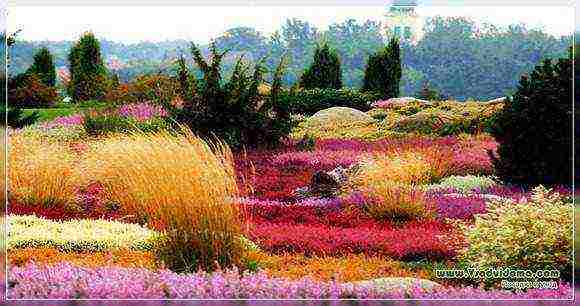
The most suitable place for heather in the garden is near low conifers: junipers, dwarf pines and Christmas trees. Low rhododendrons go well with heather.
You can plant heather as a curb plant, or place it in a rockery.
Reference by topic: Erica herbal - evergreen: photo and care
Heather varieties
Very beautiful varieties Alba Plena, Alexandra, Hammondi, Tib, Red Favorite, Dark Star, Anne-Marie, Red Star, Mazurka... I grow some of them on my site, and some are just planning to purchase.
But my most cherished dream is to break a flowerbed with varieties of heather with golden and silver foliage: Gold Haze, Boskop, Andrew Proudley, Silver Knight, Velvet Fascination.
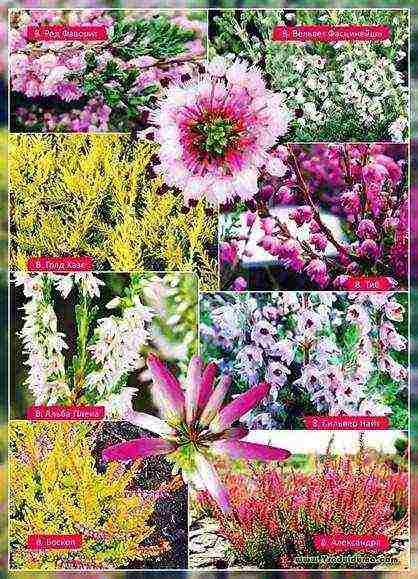
Heathers in our gardens. Heather varieties. Growing and Care Secrets - Great Video
Heathers in our gardens. Heather varieties. Growing and grooming secrets.
Below are other entries on the topic "Cottage and garden - do it yourself"
How to cut shrubs correctly: Cutting and shaping shrubs - ... Do-it-yourself decorative flower bed: How to make a decorative one with your own hands ... A simple and easy way to harvest seeds for the next year: Simple to outrageous but effective ... Arugula from seeds - growing experience: I want to share my cultivation experience arugula ... Do-it-yourself vertical bed from a barrel (photo): How to make a vertical bed of ... Cactus transplant: master class and photo: How to transplant a cactus I have ... Strawberry planting: master class and photo: How to plant strawberries correctly - ...
Subscribe to updates in our groups.
Let's be friends!
In the genus heather, there is one species, which has a dozen beautiful varieties, differing in the coloring of foliage (from white to orange) and flowers (from white to purple).
Under natural conditions, this species has a large range in Europe, starting in the north from the tundra to the southern border of coniferous-deciduous forests. In the Russian Federation, there is a large amount of heather in the north of the European part, in pine forests, in sphagnum bogs - in those places where the poorest and sourish soils are.
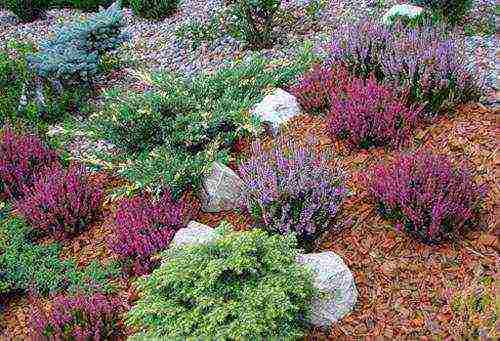
Under the heather thickets, a layer of acidic soil is formed - mixed with white sand, poor in potassium, nitrogen, phosphorus. This heather land is used in floriculture as a soil.
Heather is appreciated for its long flowering in the second decade of summer.
Common heather is widespread in Western Europe, in Russia, found in Asia Minor, in Siberia, in the north and Africa, on the Azores. In pine forests, in the tundra, on sphagnum bogs, on sands and in coniferous-deciduous forests.
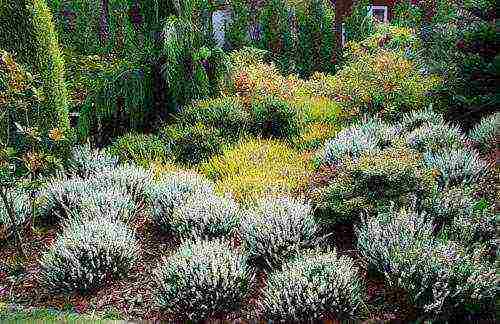
Low-growing, evergreen shrub, up to 60 cm tall. The crown of heather is compact, almost round. Brown bark. Leaves of common heather are scaly, sessile, triangular, dark green.
Heather flowers on short stalks, collected in racemose inflorescences, lilac-pink, less often white. Flowering period: July. Fruits up to 3 cm long. It grows rather slowly, 2 cm a year. Lives for about 30 years. Heather is decorative during the period of abundant and long flowering and gorgeous foliage. Heather hibernates without shelter, winter-hardy.
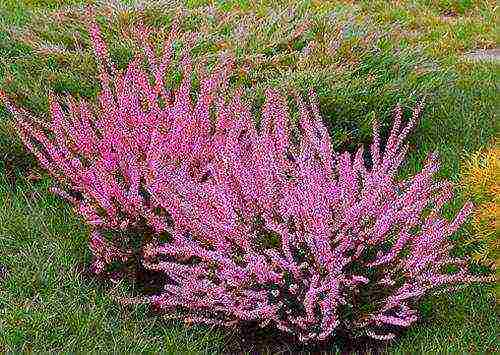
Today in Russia more than 50 varieties of heather are grown, differing in terms of flowering and coloring of flowers and leaves. Due to the many varieties of heather, you can create an interesting corner in the heather garden and extend the flowering of the garden until the end of autumn. It must be said that not all varieties of heather winter well in the middle lane, so it is best to cover them in autumn.
Heather variety with green foliage
Heather "Allegro" is an evergreen shrub, about 50 cm high. The crown is dense, compact. The bark of the heather "Allegro" is dark brown. Dark green leaves, scaly. The flowers are shiny, simple, carmine red.

The fruits are not set. It is a vigorous variety, the shoots grow upward. It grows up to 10 cm per year. Decorativeness in long and abundant flowering. Heather "Allegro" is winter-hardy. But for the winter period, it is better to cover it with a dry leaf.
Heather variety with a silvery leaf color
Heather "Silver Knight" is a low, evergreen dense bush. In height up to 30 cm. The crown of heather "Silver Knight" is compact, cushion-shaped. The leaves are fluffy, silvery gray. In winter they take on a purple hue. Very showy foliage.

The flowers of heather "Silver Knight" are lilac or light purple. Medium-sized, upright bush. The top of non-flowering shoots is drooping. Photophilous. Winter-hardy, but it is better to cover it with spruce branches.
Heather variety with double flowers
Heather "Red Favorit" - cushion shrub up to 40 cm tall, crown diameter more than 65 cm. Branches are numerous, long, broadly ascending.
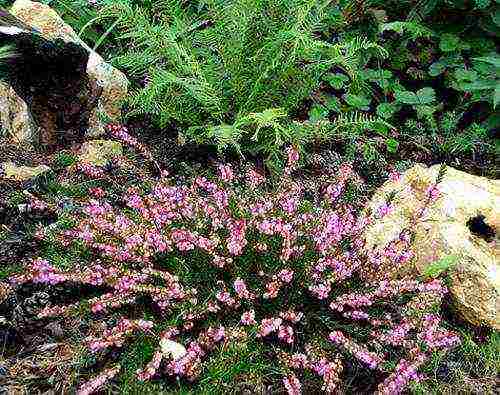
Dark green leaves. The flowers are pink, double, collected in dense inflorescences up to 10 cm long. It grows slowly.
Location of heather: heather is demanding of illumination, it grows in areas with an illumination of at least 50%, and sometimes in open places. In partial shade, common heather can easily withstand the bright March sun, but it will not bloom for long and will not bloom, and the color of the flowers will be pale. Without drainage, the bush will die in the lowland.
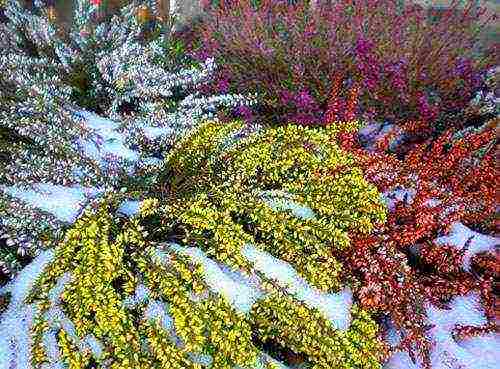
And in a dry place, the heather will winter well, but it will not give a dense crown and in the future it will completely stop blooming. Heather loves the sun very much, but light shading is also welcome. Heather grows very well on alpine hills, where water does not linger, and gravel will not let the roots of the bush dry out.
Soil: Heather favors dry, sandy and moist soils.The shrub is not picky about the richness of the soil, it is widespread on sandy acidic soils.

Planting: between plants a distance of half a meter in groups or plant 8 specimens strongly growing per 1 sq. m or 12 slow-growing varieties. Planting depth should be 25 cm.
Heather has a symbiosis with myceliums and does not tolerate transplantation very well. It is best to purchase a shrub in a container where the roots are completely preserved, this increases the percentage of plant survival.
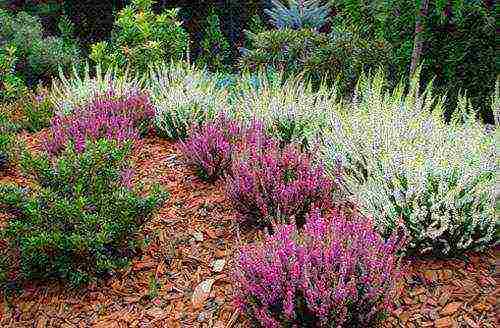
After the death of heather, the shrub retains its foliage and flowers in their original form for a long time, therefore, when you acquire, pay attention to the following:
1) heather shoots should be elastic, the tips of the branches should have buds and shoots that are lighter than the old ones;
2) the soil must be moist, not overdried;
Heather Planting Time: It is best to plant heathers in spring. They can root well over the coming season.
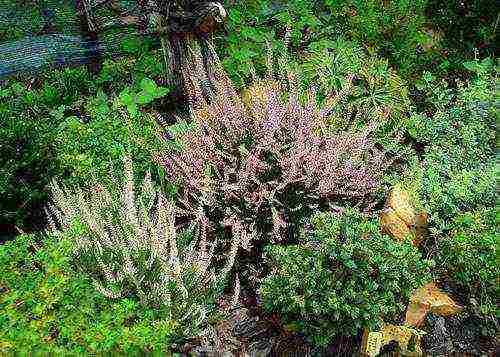
Care: Heathers in summer suffer from dry air and respond well to spraying. The root system of heathers is compact due to the huge number of branched small roots. Their short roots cannot extract moisture from the depths and need the top layer of the earth to be always moist.
Mulching: Immediately after planting heather, mulch with peat or softwood chips is needed, because it contains mycorrhiza. Chopped pine bark, large sawdust or wood chips, fern soil, peat, and even small gravel are suitable as mulch - all this well protects the soil under the heathers from drying out.
Pruning heather: No pruning is necessary for the first years after planting. After flowering in autumn or spring, old shoots are cut with pruning shears. When pruning, you should maintain the shape of the crown.

Diseases and pests: heathers hardly get sick and are not affected by pests, but viral and fungal diseases are possible.
The most common disease in heathers is gray rot, which develops with high humidity and soil. As a rule, this occurs in places where a lot of snow lingers. Plants are also damaged if they were not covered correctly or the cover was removed very late.
If the leaves of the heather turn brown, and the tops of the shoots wither, then this is a consequence of waterlogging of the soil or an excess of fertilizers. Use antifungal medications for treatment.
Symptoms of a viral disease are deformation of shoots and flowers, uncharacteristic coloration of foliage and flowers. If the plant is infected with viral infections, the bush must be dug up and then burned.
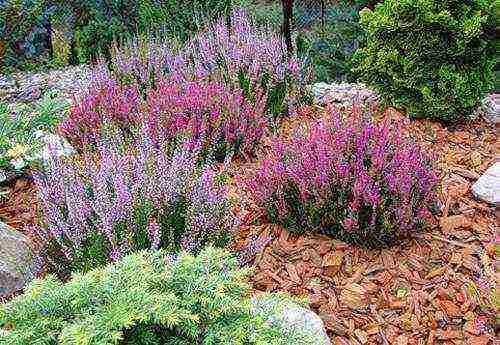
Reproduction: heather propagates by cuttings (varietal), seeds and dividing the bush.
Usage: With proper care, you can create a heather carpet that looks like a heather garden. Heathers look beautiful in combination with conifers and flowering shrubs. Usually, heathers are planted in the foreground, and bushes higher in their background.
Partners: heathers look spectacular with ferns, rhododendrons, dwarf and creeping conifers.
Materials:
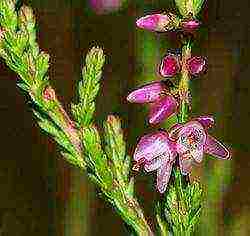 In autumn, when many plants have long faded, it is time for heathers. Its heady aroma flowers enchant, attract the eye and delight the heart of the gardener. The abundance of varieties allows you to choose the necessary color scheme for the garden. Growing this attractive plant isn't all that difficult. This article, supplemented with colorful photos, will tell you about planting, proper care and reproduction of common heather.
In autumn, when many plants have long faded, it is time for heathers. Its heady aroma flowers enchant, attract the eye and delight the heart of the gardener. The abundance of varieties allows you to choose the necessary color scheme for the garden. Growing this attractive plant isn't all that difficult. This article, supplemented with colorful photos, will tell you about planting, proper care and reproduction of common heather.
Common heather is a short, compact evergreen shrub with slow-growing shoots and incredibly fragrant flowers. All heathers are excellent honey plants. Having chosen the right varieties, you can admire the flowering of this plant from March to November.
Nowadays, there are more than 500 different varieties of flowers of various shapes, foliage color and shoot height. All of them can be conditionally divided into 3 groups:
Dwarf varieties, not exceeding 10 cm in height, spreading well on the soil surface and forming dense living "rugs", look great on rocky hills. The most common in this group are the following varieties:
- The White Lawn variety does not exceed 5 cm in height, while the diameter can be more than 40 cm. It blooms with former simple flowers in August-September.
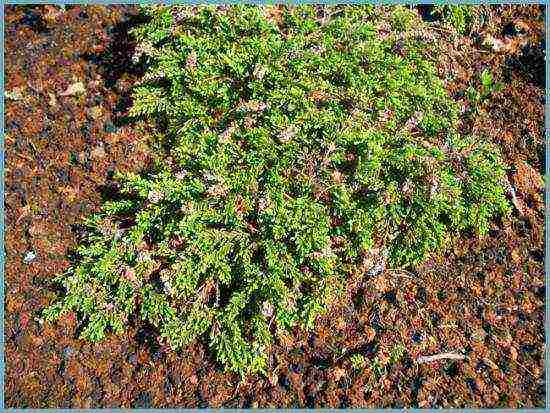
- Variety Humpty Dumpty - forms a dwarf shrub 5 cm high and 10 cm in diameter. Flowering occurs at the end of August.
- The Minima variety forms a cushion-shaped curtain 5 cm high and 15 cm in diameter. The peculiarity of the variety is non-opening flowers, pink with a lilac tone. Flowering occurs in August.
Medium-sized varieties form a clump with a height of 20-30 cm. Plants of this variety are used to create compositions for heather gardens and large rock gardens. More common varieties include:
- The Kinlochruel cultivar forms a “carpet” 40 cm in diameter and 25 cm in height. The flowering period lasts all September. It blooms with double snow-white flowers.
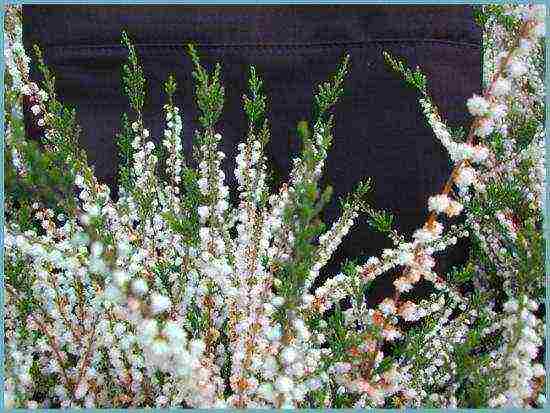
- Cottswood Gold variety. A special feature of this variety is its bright yellow foliage, which retains its color throughout the year. It blooms with small graceful white flowers from September until frost.
Tall varieties form a bush with a height of 50-60 cm. The varieties of this group are excellent for creating "heather gardens".
- The Raket cultivar is a round, compact shrub, easily reaching 55 cm in diameter and 45-50 cm in height. It blooms in late July with snow-white flowers.
- Hatje's Herbstfeuer forms a spherical shrub 50 cm high and 55 cm in diameter. A characteristic feature of this variety is its silvery-gray leaves with slight pubescence. Against the background of foliage, rather large flowers of a dark pink shade look very beautiful. Flowering begins at the end of August.
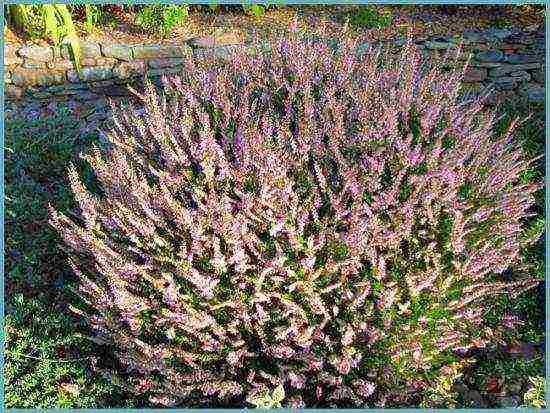
Heathers have a superficial root system with a large number of thin roots, so the culture grows better on sandy or peaty soils (with an acidity of no more than 5.5 pH) and does not grow on heavy calcareous soils. For planting heather, choose a dry, sunny location, protected from the cold wind. The planting pit is filled with such a substrate: sand, peat and bark compost mixed in a 1: 3: 2 ratio.
Important! Clumps of 10-15 plants of different colors, but of the same height, look spectacular.
Make a gap of at least 30 cm between the plants and deepen the seedling strictly to the level of the root collar. Water the planted plant with plenty of water and mulch with peat or bark.
Common heather is an unpretentious culture. If the planting is done correctly and the plants have taken root, then the heather will not need special care. Since the soil must always remain moist, the crop will need watering and evening spraying in the summer.
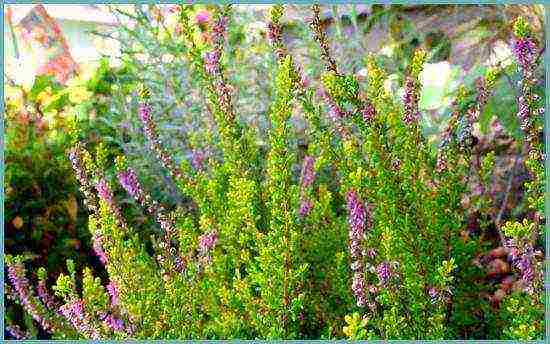
Heathers are quite frost-resistant plants, however, for better wintering, cover the soil surface with an additional layer of mulch. If there are doubts about the frost resistance of the variety, then take care of a small shelter for the winter from branches of ephedra, burlap or agrofibre.
For better growth and abundant flowering, heathers need top dressing. They are brought in once a year in May. To feed heather plantings, you can use both granular fertilizers and liquid solutions.
Important! Make sure that the nutrient solution does not come into contact with the heather leaves, as this can cause burns.
Heather reproduces in three ways:
- Dividing the mother bush is perhaps the most common and easy method. In the fall, dig a bush, shake off the roots and divide the bush into small pieces. Plant the separated plants in a prepared place.
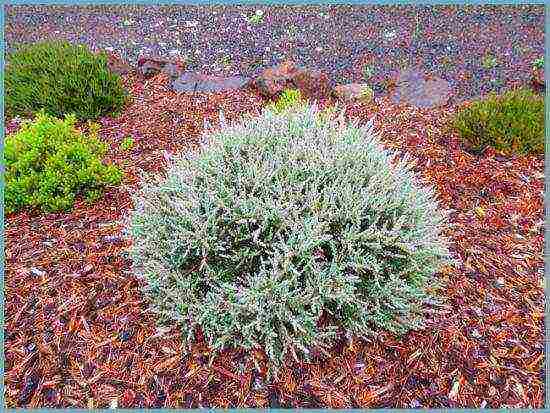
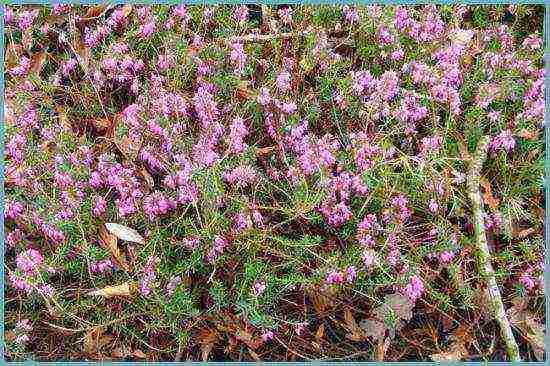
Heathers are quite resistant to many diseases and pests. Most often, problems arise with improper agricultural technology, over-watering or improper planting.

Gray rot and powdery mildew are fairly common heather diseases caused by excessive soil moisture, mineral fertilizers, or excessive winter cover. Also, the disease affects plants planted in places where melt water accumulates. A 2-3-fold treatment with any systemic antifungal drug will help to overcome this scourge. An interval of 7-10 days is maintained between treatments.
Heather leaves and shoots can be damaged by rust. Any systemic fungicide is also used for treatment.The plant is treated 2-3 times with an interval of 10 days. Areas of shoots that are damaged are removed.

Heathers go well with all representatives of heathers - this is a gault, andromeda, and impetrum, and even Japanese azaleas. In addition, cushion-shaped clumps of heather act as a link with dwarf spruce, ferns, junipers, standard and weeping pines. Heather plantings look great on alpine and rocky slides, rockeries, container containers placed on balconies and terraces.
Common heather bloom: video
3>Common heather: photo


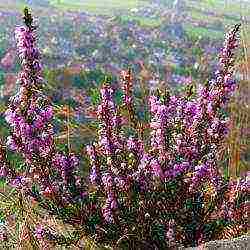
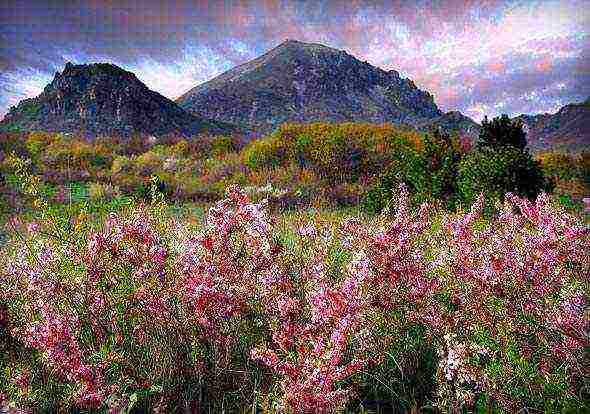

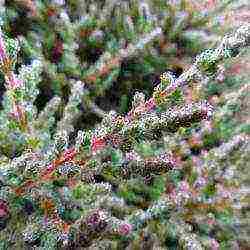
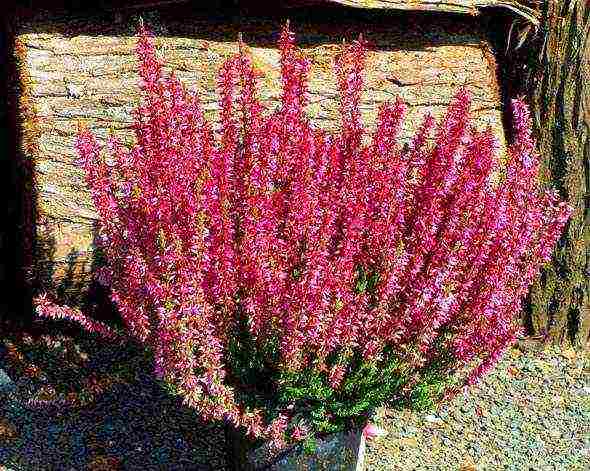
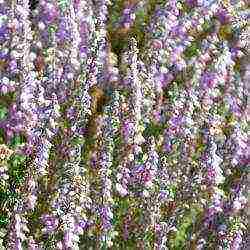
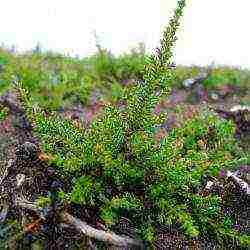
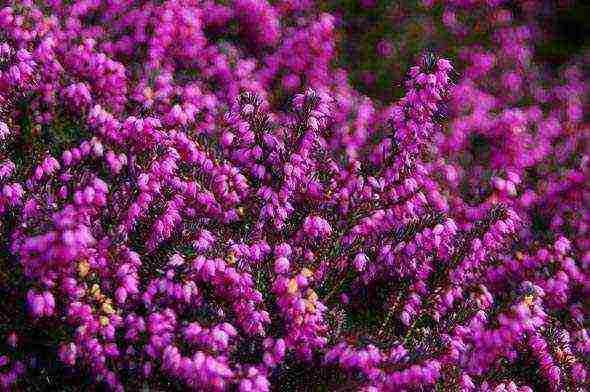
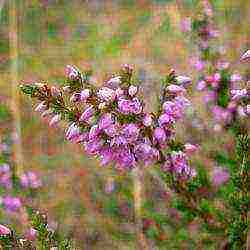


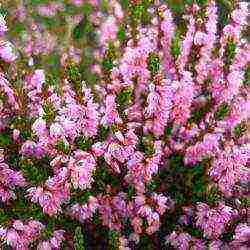

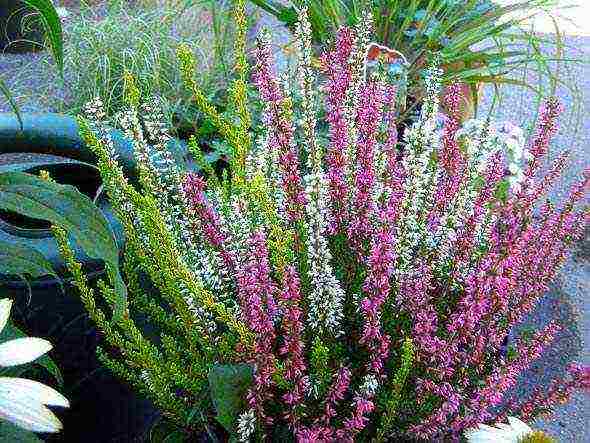
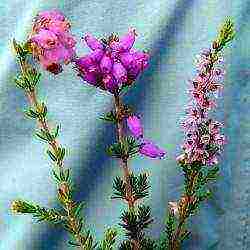
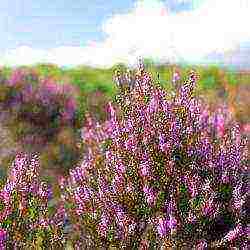
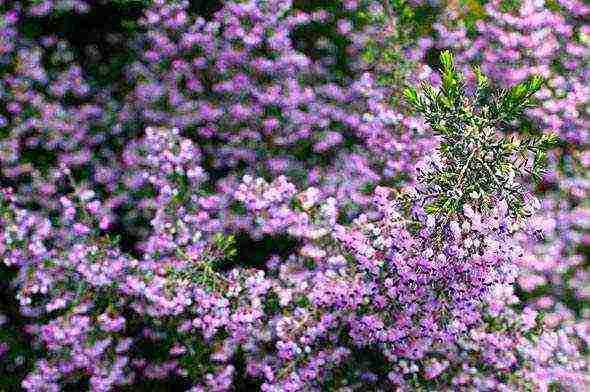
Attention competition for our subscribers!
We are giving away 10 sets of automatic irrigation "Gardena"

Also, once a week we send a digest with the most popular articles.


